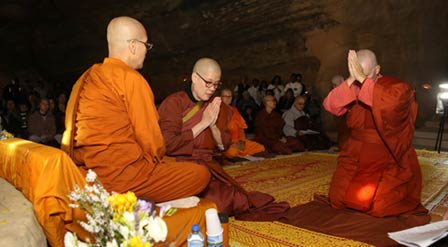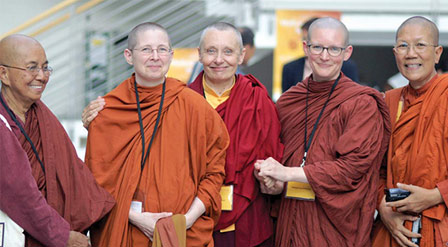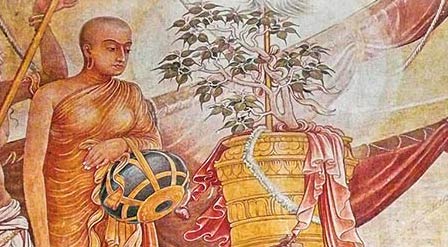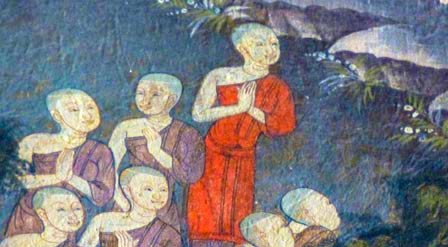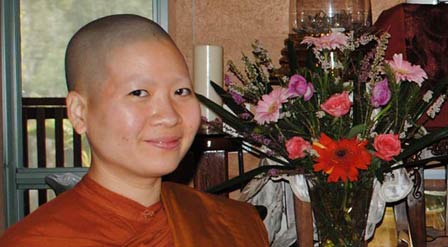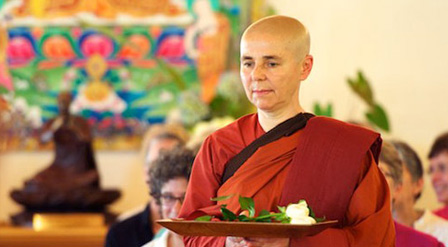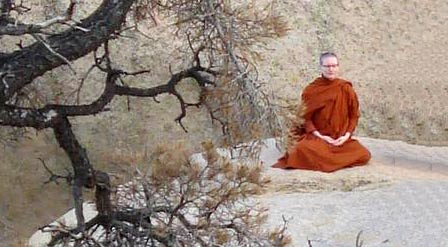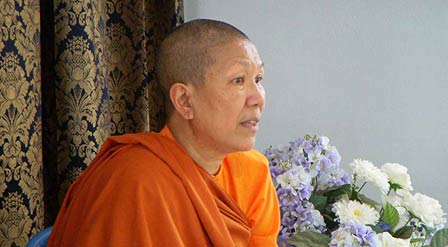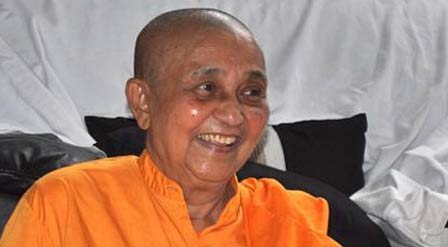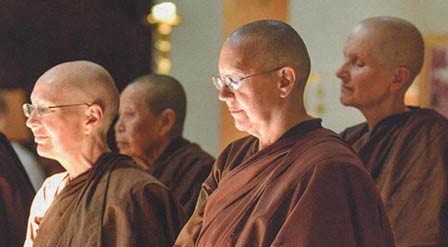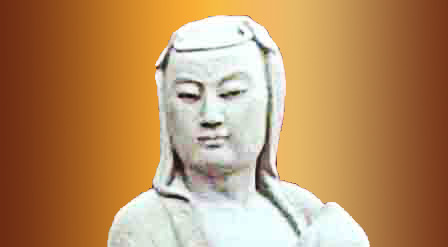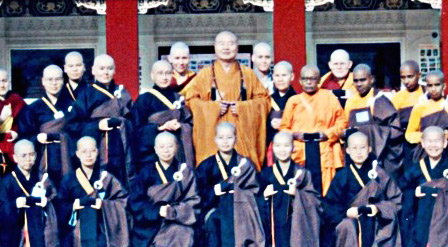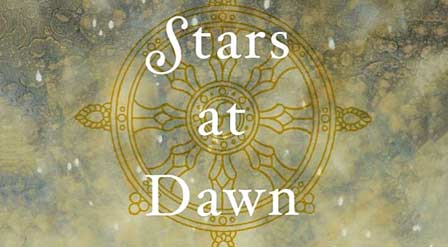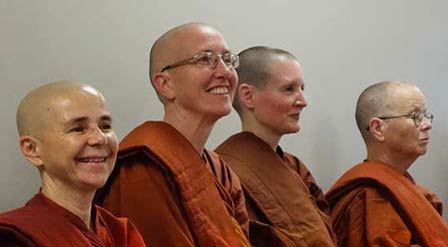Venerable Saddha Sumana
Pioneering the Bhikkhuni Sangha in the New Millenium
by Venerable Samma Samadhi
Venerable Saddha Sumana
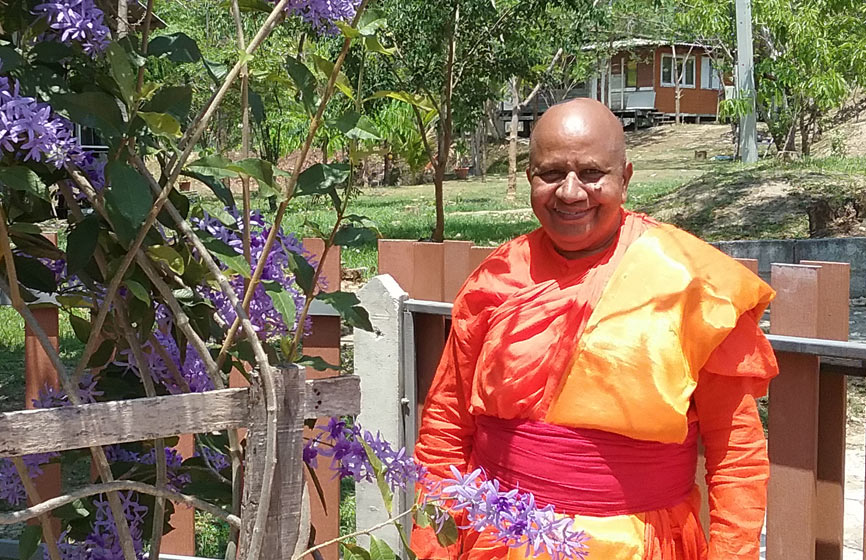
Pioneering the Bhikkhuni Sangha in the New Millenium
by Venerable Samma Samadhi
In the revival of the Theravada Bhikkhuni Sangha, the most Venerable Saddha Sumana is a groundbreaking bhikkhuni. She has been appointed and serves as a bhikkhuni preceptor in transmitting the full bhikkhuni ordination to women both in her home country of Sri Lanka and internationally, with disciples in countries including Thailand, Australia, Vietnam and Germany. She has selflessly dedicated her life to social work and the reestablishment of the bhikkhuni Sangha both in Sri Lanka and abroad. She is a great source of inspiration and energy, deeply embodying the Buddhist path and always ready to help those in need.
Venerable Saddha Sumana Bhikkhuni was born in Deltota Hospital in 1941 and grew up in Rahatungoda, Nuwara Eliya District, Hangaranketa in the highlands of central Sri Lanka. At age 15 she took ordination as a ten precept nun (dasasilamata) in a local arama. She told me that in those days Sri Lanka didn’t have very many nuns and most of them were old. In the arama where she ordained she was the only young nun, the other few nuns were 50, 60, 65 years old. Despite this she says that she never felt lonely. The older nuns were very kind to her and taught her the Dharma. They also ensured that she got a good education in the Buddhist Scriptures from a nearby monastery. She recalls that they were very strict with her about studying.
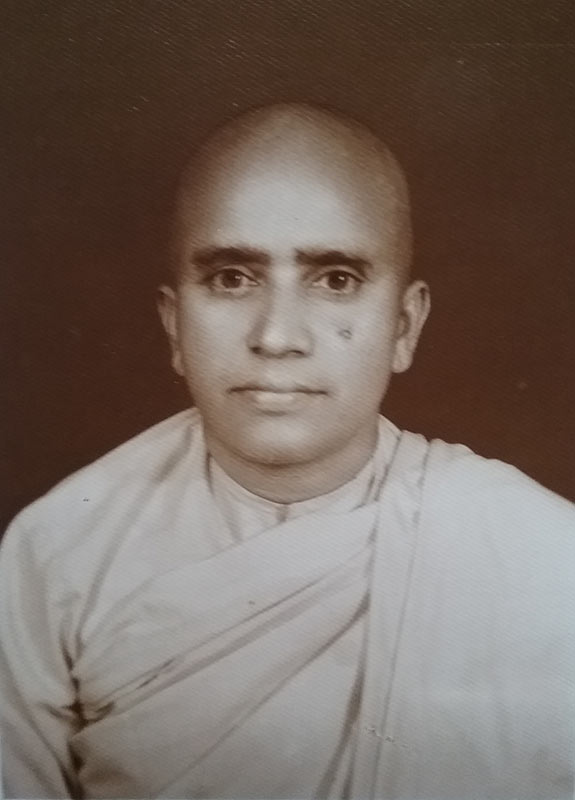 This reminds me of the time she once told me that when she was young she loved to play. She would always be finding opportunities to be naughty and playful. So when she decided that she wanted to ordain, she asked herself what she would do if she couldn’t play anymore because nuns had to be serious and dignified. But after some careful consideration she decided that she could give up being playful in order to live the holy life which was more important to her. Even now, at age 75, you can still see a glimpse of that same playful child in her dark, glittering eyes tucked below imposing, bushy eyebrows.
This reminds me of the time she once told me that when she was young she loved to play. She would always be finding opportunities to be naughty and playful. So when she decided that she wanted to ordain, she asked herself what she would do if she couldn’t play anymore because nuns had to be serious and dignified. But after some careful consideration she decided that she could give up being playful in order to live the holy life which was more important to her. Even now, at age 75, you can still see a glimpse of that same playful child in her dark, glittering eyes tucked below imposing, bushy eyebrows.
She notes that the first arama she lived in was different to most residences of ten precept nuns at the time in that they did not prepare their own food. Dana was always offered by local lay supporters. To this day, Venerable Saddha Sumana says she has never sought for the raw materials for cooking, nor personally prepared the food she ate. She considers this a fundamental part of monastic life, and even of Buddhism, in the sense that it maintains and nourishes the mutually beneficial relationship between Sangha and laity.
After almost ten years living in her first arama, she took up a more nomadic lifestyle traveling from place to place depending on where people invited her to go. She taught meditation, gave Dharma talks and conducted chanting ceremonies for sick people, pregnant women and birthday celebrations. With so few young nuns in Sri Lanka at that time, people liked her very much because she was young, intelligent and beautiful.
After her mother died in late 1963 and her father in early 1964, she decided to go and do a meditation retreat in order to generate merit to share with her deceased parents. She went to Kanduboda Meditation Centre near Colombo. This is where she met Venerable Suddhammika who at that time was still a laywoman, but after a short time took ordination with Venerable Saddha Sumana as her teacher. Since that time until now the two have never been separated. They travelled together, lived together and worked together in starting a monastery.
The monastery they started is called Sri Tusitaramaya in Eheliyagoda, a town of more than 70,000 inhabitants in the Ratnapura district of Sri Lanka. At that time some people had invited them to stay in Eheliyagoda. After some time there, their disciples and the scope of their activities were gradually increasing, so they went to the government to ask for land to start a monastery. In 1975 they were given the piece of land that is the present-day monastery, but it took four years to render in habitable and they finally moved in in 1979. At the beginning there were three nuns and one four year old girl. They had met this girl when they were staying in Eheliyagoda. Once she met the nuns she refused to go home, and so her parents were without a choice but to hand her into the care of the nuns who looked after her and sent her to school.
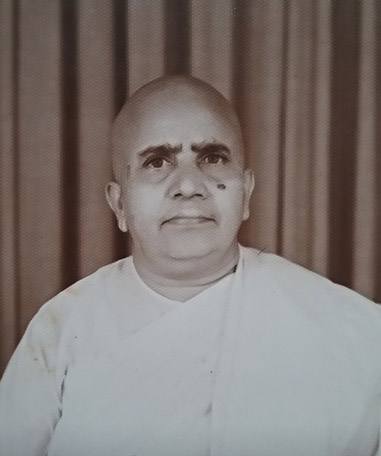 After more than 40 years as a ten precept nun, Venerable Saddha Sumana finally took Samaneri ordination at Dambulla on August 17, 1997. This was the first Samaneri ordination held in Sri Lanka, with 26 people taking ordination. Although the stipulation was that the candidates should be under 50, an exception was made for Venerable Saddha Sumana who was 56 at the time. This was because she was well known as being one of the most learned nuns in Sri Lanka and for being very active in helping society.
After more than 40 years as a ten precept nun, Venerable Saddha Sumana finally took Samaneri ordination at Dambulla on August 17, 1997. This was the first Samaneri ordination held in Sri Lanka, with 26 people taking ordination. Although the stipulation was that the candidates should be under 50, an exception was made for Venerable Saddha Sumana who was 56 at the time. This was because she was well known as being one of the most learned nuns in Sri Lanka and for being very active in helping society.
She then took higher ordination in Bodhgaya on February 21, 1998 in an ordination organised by Fo Guang Shan Temple from Taiwan. Despite the fact that she had not yet been a samaneri for two years, the requirement was waived on the basis that she had been a ten precept nun for such a long time. Altogether there were 150 candidates for ordination both male and female. Although most of them were Chinese, there were 20 candidates for bhikkhuni ordination from Sri Lanka and another 20 from India. The ordination was preceded by a one month period of training conducted by Fo Guang Shan. The training of the Chinese nuns made a great impression on Venerable Saddha Sumana, who admired their discipline and cooperation. Since then she has been known to advise some of her students to undergo further training in the Chinese tradition in order to learn discipline and the ability to work in a group.
After the Dual Ordination via the Chinese Dharmaguptaka traditional rite, the group of 20 Sri Lankan bhikkhunis went to Sarnath and had a second dalhikamma (“strengthening”) ordination via the traditional Pali-text rite with the Theravada Bhikkhu Sangha alone, in a ceremony presided over by 12 eminent Sri Lankan monks. This was done as they wanted to make sure that their ordination would be valid according to the Theravada tradition. The quorum of monks included highly-revered and world renowned Theravada monastic elders such as the most venerable Henepola Gunaratana (affectionately known as “Bhante G”), now based in America, and the late most Venerable K. Sri Dhammananda.
After coming back to Sri Lanka the newly ordained bhikkhunis attended a one month workshop conducted by senior Sri Lankan monks at Dambulla. They learnt how to confess their offences, how to recite the Patimokkha and how to confer ordination. Even though the Vinaya stipulates that a bhikkhuni must have at least 12 Vassas before she is eligible to be a preceptor, the newly ordained bhikkhunis had all been in robes for more than three decades. While they were in India, they discussed with the Taiwanese monks and nuns from Fo Guang Shan the possibility of being able to confer ordination even without twelve years seniority, on the basis that their training and experience in monastic life was already far in excess of twelve years. Fo Guang Shan agreed that they could confer ordination without waiting 12 years. Thus several of the bhikkhunis who were senior-most and most experienced in monastic life were agreed upon and appointed as preceptors, Venerable Saddha Sumana among them. They began conferring upasampada on several female novices beginning in March 1998, thereby re-establishing the bhikkhuni order in Sri Lanka.
At the closing of the one month training period Venerable Saddha Sumana was ready to return to Eheliyagoda, the town where her temple is located. A massive welcome-back celebration had been organized in advance. Banners with her name and picture had been hung all over the town to publicize the event. The ceremony was held at the Central Meeting Hall in Eheliyagoda and was attended by many monks, ten-precepts nuns and distinguished guests. In total, there were more than 1500 people present at the ceremony and Venerable Saddha Sumana capped off the event by giving a wonderful dharma talk. That night a group of senior monks were invited to Sri Tusitaramaya to do all-night chanting of protective blessings.
Venerable Saddha Sumana says there is a “vast difference” between being a ten-precept nun and a bhikkhuni. The restraint of the 311 precepts of the Patimokkha is far more thorough than the ten precepts she held previously. She also felt that since taking bhikkhuni ordination her mind has been calmer. Furthermore, taking bhikkhuni ordination meant a change in her relationship with the laity. People expected more of her as a bhikkhuni, but at the same time were more supportive and generous. They felt that their offerings were now being made to Sangha members and so rejoiced in finally being able to offer Sangha-dana to bhikkhunis. Ten precept nuns are not officially considered to be members of the Sangha.
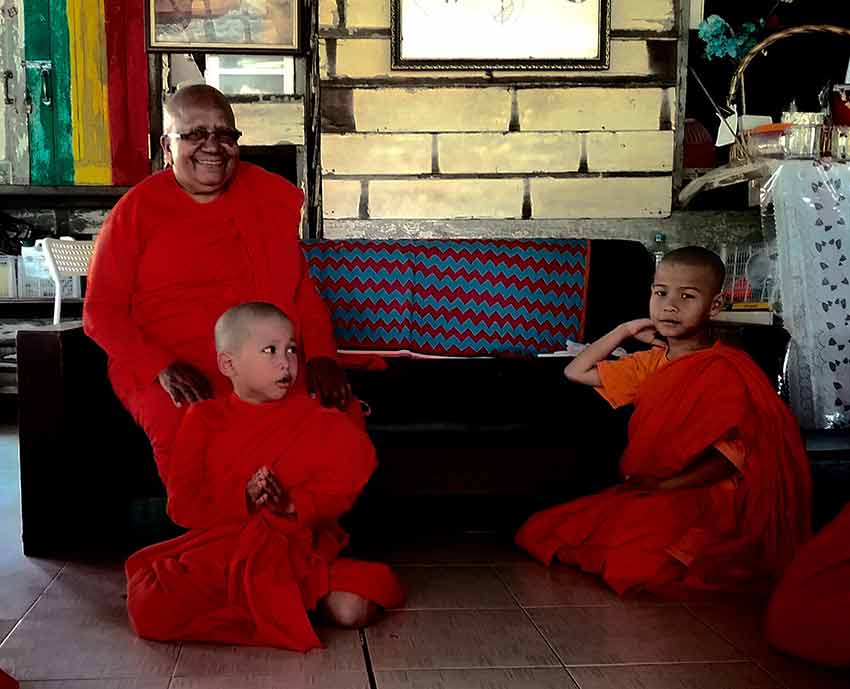
Venerable Saddha Sumana with young samaneris who temporarily ordained with her in Thailand.
Since taking bhikkhuni ordination, Venerable Saddha Sumana has become an important figure involved in the resurrection of the bhikkhuni order around the world. She has travelled to various countries to act as preceptor, and has ordained close to 200 bhikkhunis from a number of different countries including Sri Lanka, Australia, Thailand and Vietnam. The number of samaneris she has ordained, including temporary ordinations, is probably somewhere in the thousands. Importantly, Venerable Saddha Sumana conferred bhikkhuni ordination on Venerable Dhammananda from Thailand in 2003. Now thirteen years later Venerable Dhammananda has become a preceptor herself and is capable of perpetuating the bhikkhuni lineage within Thailand, a Buddhist country that has been totally lacking the presence of bhikkhunis in modern times.
In Sri Lanka she has continued to actively help society and provide a place of refuge for women to go and practice in her arama. She was elected as a Justice of the Peace for the island of Sri Lanka, and for many years she was involved with the organization Samatha Mandalay, which helped people to settle their disputes without having to go to court. Every Sunday in the early afternoon in Sri Tusitaramaya we would see a little figure dressed in bright orange carrying a yellow umbrella slowly disappearing down the hill to go and attend the weekly Samatha Mandalay board. Only recently due to old age and ill health has she resigned from the position. Apart from this, Venerable Saddha Sumana also started a Sunday Dharma School in her arama, teaching weekly Dharma classes to more than 250 children from ages 5 to 17. At present various areas of the monastery are used to conduct the Dharma lessons, but building is underway to construct a two-story Dharma school to improve the convenience and quality of learning for the students.
This year, the 2600 year anniversary of the bhikkhuni sangha, also marks 60 years of Venerable Saddha Sumana’s life in robes. This is her 19th rains as a bhikkhuni, and as she said, with characteristic mischievous humour, if she doesn’t die in the mean time, next year with the completion of the 2600 Bhikkhuni Sangha Centennial, she will be a mahatheri. Ven Saddha Sumana is a pioneer in the true sense of the word. Devoting her whole life to the practice of the Buddha-Dhamma, she has also engendered the understanding and practice of Dharma in all her students through her keen guidance and wonderful good humour. She is a real inspiration to all those she comes into contact with. We, her students, hold her very warmly, and with much love and metta, within our hearts. May she continue her great work in spreading the Buddha-Dhamma and encouraging young females to take robes and fully live out the holy life.
Theruwan Saranai! ~ Blessings of the Triple Gem!
About the Author
In the revival of the Theravada Bhikkhuni Sangha, the most Venerable Saddha Sumana is a groundbreaking bhikkhuni. She has been appointed and serves as a bhikkhuni preceptor in transmitting the full bhikkhuni ordination to women both in her home country of Sri Lanka and internationally, with disciples in countries including Thailand, Australia, Vietnam and Germany. She has selflessly dedicated her life to social work and the reestablishment of the bhikkhuni Sangha both in Sri Lanka and abroad. She is a great source of inspiration and energy, deeply embodying the Buddhist path and always ready to help those in need.
Venerable Saddha Sumana Bhikkhuni was born in Deltota Hospital in 1941 and grew up in Rahatungoda, Nuwara Eliya District, Hangaranketa in the highlands of central Sri Lanka. At age 15 she took ordination as a ten precept nun (dasasilamata) in a local arama. She told me that in those days Sri Lanka didn’t have very many nuns and most of them were old. In the arama where she ordained she was the only young nun, the other few nuns were 50, 60, 65 years old. Despite this she says that she never felt lonely. The older nuns were very kind to her and taught her the Dharma. They also ensured that she got a good education in the Buddhist Scriptures from a nearby monastery. She recalls that they were very strict with her about studying.
 This reminds me of the time she once told me that when she was young she loved to play. She would always be finding opportunities to be naughty and playful. So when she decided that she wanted to ordain, she asked herself what she would do if she couldn’t play anymore because nuns had to be serious and dignified. But after some careful consideration she decided that she could give up being playful in order to live the holy life which was more important to her. Even now, at age 75, you can still see a glimpse of that same playful child in her dark, glittering eyes tucked below imposing, bushy eyebrows.
This reminds me of the time she once told me that when she was young she loved to play. She would always be finding opportunities to be naughty and playful. So when she decided that she wanted to ordain, she asked herself what she would do if she couldn’t play anymore because nuns had to be serious and dignified. But after some careful consideration she decided that she could give up being playful in order to live the holy life which was more important to her. Even now, at age 75, you can still see a glimpse of that same playful child in her dark, glittering eyes tucked below imposing, bushy eyebrows.
She notes that the first arama she lived in was different to most residences of ten precept nuns at the time in that they did not prepare their own food. Dana was always offered by local lay supporters. To this day, Venerable Saddha Sumana says she has never sought for the raw materials for cooking, nor personally prepared the food she ate. She considers this a fundamental part of monastic life, and even of Buddhism, in the sense that it maintains and nourishes the mutually beneficial relationship between Sangha and laity.
After almost ten years living in her first arama, she took up a more nomadic lifestyle traveling from place to place depending on where people invited her to go. She taught meditation, gave Dharma talks and conducted chanting ceremonies for sick people, pregnant women and birthday celebrations. With so few young nuns in Sri Lanka at that time, people liked her very much because she was young, intelligent and beautiful.
After her mother died in late 1963 and her father in early 1964, she decided to go and do a meditation retreat in order to generate merit to share with her deceased parents. She went to Kanduboda Meditation Centre near Colombo. This is where she met Venerable Suddhammika who at that time was still a laywoman, but after a short time took ordination with Venerable Saddha Sumana as her teacher. Since that time until now the two have never been separated. They travelled together, lived together and worked together in starting a monastery.
The monastery they started is called Sri Tusitaramaya in Eheliyagoda, a town of more than 70,000 inhabitants in the Ratnapura district of Sri Lanka. At that time some people had invited them to stay in Eheliyagoda. After some time there, their disciples and the scope of their activities were gradually increasing, so they went to the government to ask for land to start a monastery. In 1975 they were given the piece of land that is the present-day monastery, but it took four years to render in habitable and they finally moved in in 1979. At the beginning there were three nuns and one four year old girl. They had met this girl when they were staying in Eheliyagoda. Once she met the nuns she refused to go home, and so her parents were without a choice but to hand her into the care of the nuns who looked after her and sent her to school.
 After more than 40 years as a ten precept nun, Venerable Saddha Sumana finally took Samaneri ordination at Dambulla on August 17, 1997. This was the first Samaneri ordination held in Sri Lanka, with 26 people taking ordination. Although the stipulation was that the candidates should be under 50, an exception was made for Venerable Saddha Sumana who was 56 at the time. This was because she was well known as being one of the most learned nuns in Sri Lanka and for being very active in helping society.
After more than 40 years as a ten precept nun, Venerable Saddha Sumana finally took Samaneri ordination at Dambulla on August 17, 1997. This was the first Samaneri ordination held in Sri Lanka, with 26 people taking ordination. Although the stipulation was that the candidates should be under 50, an exception was made for Venerable Saddha Sumana who was 56 at the time. This was because she was well known as being one of the most learned nuns in Sri Lanka and for being very active in helping society.
She then took higher ordination in Bodhgaya on February 21, 1998 in an ordination organised by Fo Guang Shan Temple from Taiwan. Despite the fact that she had not yet been a samaneri for two years, the requirement was waived on the basis that she had been a ten precept nun for such a long time. Altogether there were 150 candidates for ordination both male and female. Although most of them were Chinese, there were 20 candidates for bhikkhuni ordination from Sri Lanka and another 20 from India. The ordination was preceded by a one month period of training conducted by Fo Guang Shan. The training of the Chinese nuns made a great impression on Venerable Saddha Sumana, who admired their discipline and cooperation. Since then she has been known to advise some of her students to undergo further training in the Chinese tradition in order to learn discipline and the ability to work in a group.
After the Dual Ordination via the Chinese Dharmaguptaka traditional rite, the group of 20 Sri Lankan bhikkhunis went to Sarnath and had a second dalhikamma (“strengthening”) ordination via the traditional Pali-text rite with the Theravada Bhikkhu Sangha alone, in a ceremony presided over by 12 eminent Sri Lankan monks. This was done as they wanted to make sure that their ordination would be valid according to the Theravada tradition. The quorum of monks included highly-revered and world renowned Theravada monastic elders such as the most venerable Henepola Gunaratana (affectionately known as “Bhante G”), now based in America, and the late most Venerable K. Sri Dhammananda.
After coming back to Sri Lanka the newly ordained bhikkhunis attended a one month workshop conducted by senior Sri Lankan monks at Dambulla. They learnt how to confess their offences, how to recite the Patimokkha and how to confer ordination. Even though the Vinaya stipulates that a bhikkhuni must have at least 12 Vassas before she is eligible to be a preceptor, the newly ordained bhikkhunis had all been in robes for more than three decades. While they were in India, they discussed with the Taiwanese monks and nuns from Fo Guang Shan the possibility of being able to confer ordination even without twelve years seniority, on the basis that their training and experience in monastic life was already far in excess of twelve years. Fo Guang Shan agreed that they could confer ordination without waiting 12 years. Thus several of the bhikkhunis who were senior-most and most experienced in monastic life were agreed upon and appointed as preceptors, Venerable Saddha Sumana among them. They began conferring upasampada on several female novices beginning in March 1998, thereby re-establishing the bhikkhuni order in Sri Lanka.
At the closing of the one month training period Venerable Saddha Sumana was ready to return to Eheliyagoda, the town where her temple is located. A massive welcome-back celebration had been organized in advance. Banners with her name and picture had been hung all over the town to publicize the event. The ceremony was held at the Central Meeting Hall in Eheliyagoda and was attended by many monks, ten-precepts nuns and distinguished guests. In total, there were more than 1500 people present at the ceremony and Venerable Saddha Sumana capped off the event by giving a wonderful dharma talk. That night a group of senior monks were invited to Sri Tusitaramaya to do all-night chanting of protective blessings.
Venerable Saddha Sumana says there is a “vast difference” between being a ten-precept nun and a bhikkhuni. The restraint of the 311 precepts of the Patimokkha is far more thorough than the ten precepts she held previously. She also felt that since taking bhikkhuni ordination her mind has been calmer. Furthermore, taking bhikkhuni ordination meant a change in her relationship with the laity. People expected more of her as a bhikkhuni, but at the same time were more supportive and generous. They felt that their offerings were now being made to Sangha members and so rejoiced in finally being able to offer Sangha-dana to bhikkhunis. Ten precept nuns are not officially considered to be members of the Sangha.

Venerable Saddha Sumana with young samaneris who temporarily ordained with her in Thailand.
Since taking bhikkhuni ordination, Venerable Saddha Sumana has become an important figure involved in the resurrection of the bhikkhuni order around the world. She has travelled to various countries to act as preceptor, and has ordained close to 200 bhikkhunis from a number of different countries including Sri Lanka, Australia, Thailand and Vietnam. The number of samaneris she has ordained, including temporary ordinations, is probably somewhere in the thousands. Importantly, Venerable Saddha Sumana conferred bhikkhuni ordination on Venerable Dhammananda from Thailand in 2003. Now thirteen years later Venerable Dhammananda has become a preceptor herself and is capable of perpetuating the bhikkhuni lineage within Thailand, a Buddhist country that has been totally lacking the presence of bhikkhunis in modern times.
In Sri Lanka she has continued to actively help society and provide a place of refuge for women to go and practice in her arama. She was elected as a Justice of the Peace for the island of Sri Lanka, and for many years she was involved with the organization Samatha Mandalay, which helped people to settle their disputes without having to go to court. Every Sunday in the early afternoon in Sri Tusitaramaya we would see a little figure dressed in bright orange carrying a yellow umbrella slowly disappearing down the hill to go and attend the weekly Samatha Mandalay board. Only recently due to old age and ill health has she resigned from the position. Apart from this, Venerable Saddha Sumana also started a Sunday Dharma School in her arama, teaching weekly Dharma classes to more than 250 children from ages 5 to 17. At present various areas of the monastery are used to conduct the Dharma lessons, but building is underway to construct a two-story Dharma school to improve the convenience and quality of learning for the students.
This year, the 2600 year anniversary of the bhikkhuni sangha, also marks 60 years of Venerable Saddha Sumana’s life in robes. This is her 19th rains as a bhikkhuni, and as she said, with characteristic mischievous humour, if she doesn’t die in the mean time, next year with the completion of the 2600 Bhikkhuni Sangha Centennial, she will be a mahatheri. Ven Saddha Sumana is a pioneer in the true sense of the word. Devoting her whole life to the practice of the Buddha-Dhamma, she has also engendered the understanding and practice of Dharma in all her students through her keen guidance and wonderful good humour. She is a real inspiration to all those she comes into contact with. We, her students, hold her very warmly, and with much love and metta, within our hearts. May she continue her great work in spreading the Buddha-Dhamma and encouraging young females to take robes and fully live out the holy life.
Theruwan Saranai! ~ Blessings of the Triple Gem!

